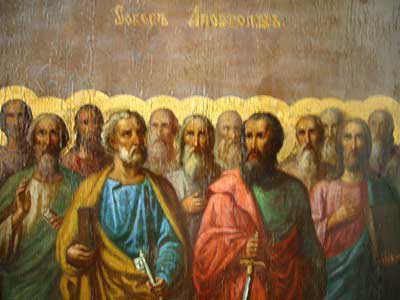The Twelve Apostles, 19th Century CE
Oil on Wood Panel
19.5
PF.5983
Further images
Russians inherited the tradition of icon painting from Byzantium, where it began as an offshoot of the mosaic and fresco tradition. During the 8th and 9th centuries, the iconoclastic controversy...
Russians inherited the tradition of icon painting from Byzantium, where it began as an offshoot of the mosaic and fresco tradition. During the 8th and 9th centuries, the iconoclastic controversy in the Orthodox Church called into question whether religious images were a legitimate practice or sacrilegious idolatry. Although the use of images was in the end permitted, a thorough distinction between profane art intended to depict reality and sacred art designed for spiritual contemplation was established. That difference is one of the reasons that the artistic style of icons can seem so invariant. Certain kinds of balance and harmony became established as reflections of divinity, and as such they invited careful reproduction and subtle refinement rather than striking novelty. Although this philosophy resulted in a comparatively slow evolution of style, icon painting evolved considerably over the centuries. Unlike the pictorial traditions of the west that aspire towards increased realism and naturalism, the essence of Russian icon painting is not about the representation of physical space or appearance. Icons are images intended to aid in contemplative prayer, and in that sense, are more concerned with conveying meditative harmony than with laying out a realistic scene. They were not painted to please the eye of the mind, but to inspire reflection and self-examination.
When Jesus walked on the earth he chose twelve men to follow closely and learn from him. These men spent about two years traveling with Jesus. They heard his teaching and parables, saw him work miracles, and experienced the wonders of daily life with the Lord. Importantly, these were not learned theologians. Jesus ran into opposition from the religious establishment because he and his apostles often broke the traditional rules. Much of our knowledge of the life of Christ survives in the writings of the apostles who continued his work and spread his faith. Pictured most prominently in this icon are St. Peter, recognized by the key he holds and considered the leader among the twelve, and St. James who can be identified by the sword of the martyr (James was the first of the twelve to be martyred). Next to James is his brother St. John the Evangelist who appears holding a book in his characteristic youthful appearance. To the left of Peter is another prominent apostle, most likely St. Matthew. He holds a rolled scroll that might symbolize his Gospels. The other eight apostles are rendered in a similar aged style with thick gray beards. Only two others stand out for their youth; both flank St. Matthew on the far left. Perhaps one of these is the infamous Judas, who, even though be betrayed Christ, is represented as a holy figure replete with a halo. Christ lived an exemplary life and died to redeem the sins of mankind. Were it not for the writings and actions of his disciples, his story and words might have died with him upon the cross. This gorgeous icon represents those who carried on the legacy of Christ and established the foundation from which his legend has flourished.
When Jesus walked on the earth he chose twelve men to follow closely and learn from him. These men spent about two years traveling with Jesus. They heard his teaching and parables, saw him work miracles, and experienced the wonders of daily life with the Lord. Importantly, these were not learned theologians. Jesus ran into opposition from the religious establishment because he and his apostles often broke the traditional rules. Much of our knowledge of the life of Christ survives in the writings of the apostles who continued his work and spread his faith. Pictured most prominently in this icon are St. Peter, recognized by the key he holds and considered the leader among the twelve, and St. James who can be identified by the sword of the martyr (James was the first of the twelve to be martyred). Next to James is his brother St. John the Evangelist who appears holding a book in his characteristic youthful appearance. To the left of Peter is another prominent apostle, most likely St. Matthew. He holds a rolled scroll that might symbolize his Gospels. The other eight apostles are rendered in a similar aged style with thick gray beards. Only two others stand out for their youth; both flank St. Matthew on the far left. Perhaps one of these is the infamous Judas, who, even though be betrayed Christ, is represented as a holy figure replete with a halo. Christ lived an exemplary life and died to redeem the sins of mankind. Were it not for the writings and actions of his disciples, his story and words might have died with him upon the cross. This gorgeous icon represents those who carried on the legacy of Christ and established the foundation from which his legend has flourished.





